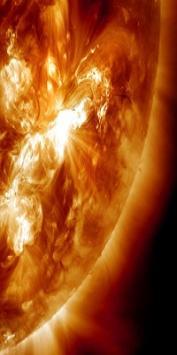Solar-flare forecasting with multi-wavelength data
 Major space weather events have their origin in activity on the Sun.
Major space weather events have their origin in activity on the Sun.
Solar flares and coronal mass ejections can cause damage to space hardware, and also to terrestrial systems such as power distribution. Can we learn to predict flares and ejections well enough to give useful warning?
Our approach
Understanding and predicting solar activity involves a combination of mathematical modeling and analysis of data taken in many wavelengths of radiation: both present huge computational challenges. Focusing on observations, the task is to automatically detect, measure and characterise features such as sunspots, prominences, and coronal loops in multi-wavelength images of solar active regions (digital image processing and machine learning); to analyse the relationships between features, their evolution, and the occurrence of activity (synthesis); and finally to interpret these in terms of robust physical rules which have predictive power (theory).
Why is this research important?
Forecasting the space weather is as important to satellite operators as forecasting the terrestrial weather is to airlines or shipping companies. The ability to identify the early signs that a flare or ejection will happen, or being able to give a robust likelihood that a given region on the Sun will produce a flare, gives additional warning time of major events, and can inform operational strategies for space hardware.

